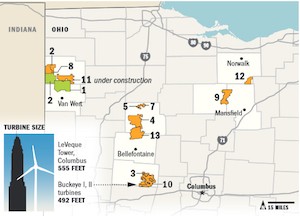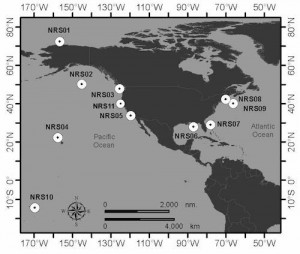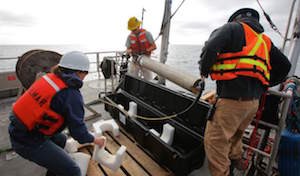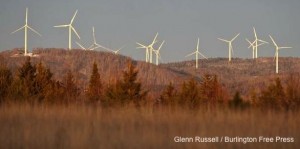Ohio “wind energy killing” setbacks: reports of wind’s death were greatly exaggerated
Human impacts, Wind turbines Comments Off on Ohio “wind energy killing” setbacks: reports of wind’s death were greatly exaggerated Once again the wind industry has been caught crying wolf about reasonable and workable setback increases. In 2014, the Ohio legislature tweaked the state’s wind farm siting standards to require setbacks of 1300 feet from neighboring property lines, rather than from neighboring homes. Wind energy advocates gnashed their teeth, with an executive of the national trade association, AWEA, claiming that “This would kill further wind energy development in Ohio unless the governor vetoes it,” while the CEO of wind developer Apex Clean Energy chimed in that with such odious setbacks, Apex “will have no choice but to take its investment and its business elsewhere. ”
Once again the wind industry has been caught crying wolf about reasonable and workable setback increases. In 2014, the Ohio legislature tweaked the state’s wind farm siting standards to require setbacks of 1300 feet from neighboring property lines, rather than from neighboring homes. Wind energy advocates gnashed their teeth, with an executive of the national trade association, AWEA, claiming that “This would kill further wind energy development in Ohio unless the governor vetoes it,” while the CEO of wind developer Apex Clean Energy chimed in that with such odious setbacks, Apex “will have no choice but to take its investment and its business elsewhere. ”
Get ready for a shock, AWEA: Amazon, not phased at all by the setbacks, has announced plans to build a 100-MW wind farm to power two new distribution centers in Ohio. And, in a late-2014 review of the status of 11 projects that are in the pipeline, it was federal tax credits and lapsed state renewable energy incentives that were cited as current challenges, not the setbacks. While it’s quite possible that previously-approved projects are proceeding under the old setback rules, the same statewide overview notes that “several other companies, including Apex Clean Energy of Virginia, are acquiring lease rights and working on plans.” (Wait, what? Yup, the same outfit that just told us the setbacks ruined everything so they’d be taking their toys and going home still have four Ohio projects in the pipeline.)
It’s disheartening to see the wind industry employing these same shopworn scare tactics about moderate setbacks; no matter what the proposal, if it’s an increase over something that has been on the table, it’s decried as “killing” the possibility of wind energy in the area. Anything over the 750-1000 foot setbacks that the industry prefers is considered extreme; in Ohio, claims that the old 1300-ft to homes setback was among the most stringent in the nation are practically a joke, with 1250-1500-foot limits now becoming the norm, and many areas going much further. In Minnesota, a 1500-ft setback was eagerly embraced in lieu of a proposed 2700-ft rule; in Maine, a 2000-ft setback was deemed perfectly workable by a developer who was fighting a change to 4000-ft, after which they switched gears and pinpointed a 35dBA noise limit as the real “deal killer.”
Indeed, nighttime noise limits of 35dB or less can mean that setbacks will need to be large enough (4000 feet or more) to rule out development in most communities. Still, it’s entirely reasonable for some towns to choose such low noise limits, or setbacks of a half mile or more, if the priority is to preseve the rural character of place and assure that few if any residents will hear turbine noise on a regular basis. Ideally, these more restrictive rules would also include the option that wind developers can obtain noise easements from neighbors who are willing to live closer to turbines (often in return for a financial payout, either one-time or annual). And guess what? The much-decried Ohio rules do allow individual landowners to waive the setback requirement, if they wish to; this may be part of why so many projects are still happening. It’s time for the wind industry to stop moaning about setbacks meant to preserve some semblance of rural character, and begin making peace with the fact that not all communities will make the same choices about opportunities for economic development.
Looking ahead in Ohio: Even as Amazon, Apex, and others proceed with their plans in Ohio, representatives from several northwestern Ohio districts have introduced a bill to let counties supersede the state rules and revert to the old setback standards on a case by case basis. (Will it surprise you to hear that it’s in this very region where Amazon is happy to build with the current rules? I thought not….) So far, there does not seem to be any active reconsideration of the other key element of the 2014 rule changes in Ohio, a 2-year freeze of the state renewable energy portfolio standard (RPS) at 2.5%—foregoing the planned 1% annual increases toward a 2025 goal of 12.5%—while the legislature reviews the RPS program. Presumably, a decision will be made during the coming year whether to revert to the old schedule or adopt new, lower targets.
UPDATE, 1/29/2016: While I’m not tracking all the news related to new projects, a couple of things caught my eye recently. Two companies, including Apex, abandoned plans for wind farms in Ohio, though the news reports, and perhaps the formal notices filed with state regulators, don’t specify why; there are many reasons that proposed project aren’t completed, including the financial health of the companies themselves, and the fact that they often do preliminary work in many more places than they ultimately choose to build. Relatedly, the Scioto Ridge Wind Farm, which was among those supposedly threatened by the new Ohio rules, is still under development; on January 26, the project’s Facebook page recently posted a local news article about an agreement reached between Everpower and a local opposition group, which reduced the number of turbines from 176 to 107; such reductions sometimes involve a move to bigger turbines, and it’s unclear whether the footprint is smaller (and so some setbacks larger) under the agreement. Nonetheless, another local group has vowed to continue fighting the plans.


 The most recent deployment
The most recent deployment 